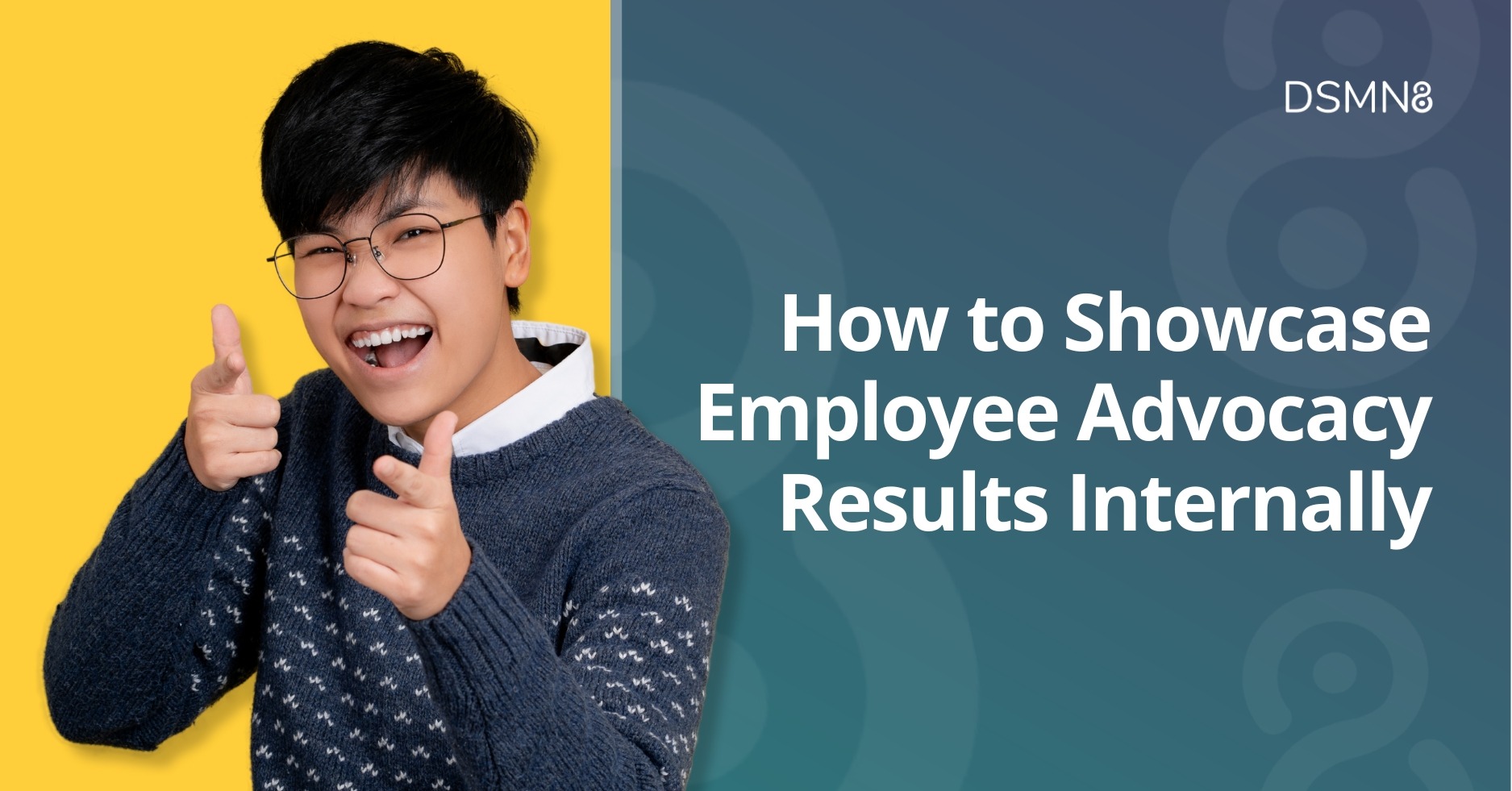
When running an employee advocacy program, it’s easy to focus on the day-to-day management: creating and curating content for employees to share and tracking the analytics.
But it’s incredibly important to remember to shout about your program’s results internally. I’d go as far as saying it’s critical for long-term success.
Today, you’ll learn why it’s so fundamental to regularly share employee advocacy successes beyond the marketing team. You’ll also find out which results to focus on for the biggest impact and discover opportunities to highlight these wins.
We’ll cover six reasons to promote advocacy results internally, eight ways to showcase the impact within your organization, and finally, which employee advocacy results to emphasize.
Why It’s Important to Share Employee Advocacy Results Internally
By making your employee advocacy results visible throughout your company, it becomes much easier to sustain program momentum 📈
The more employee advocacy (and its impact) is discussed across different business units and in various contexts, the more it becomes part of your company culture.
The goal here is to ensure that employees don’t forget the program exists! Consistently being reminded about the positive results is an effective motivator for your brand ambassadors.
With that said, let’s dive into six specific scenarios and reasons to highlight your program wins:
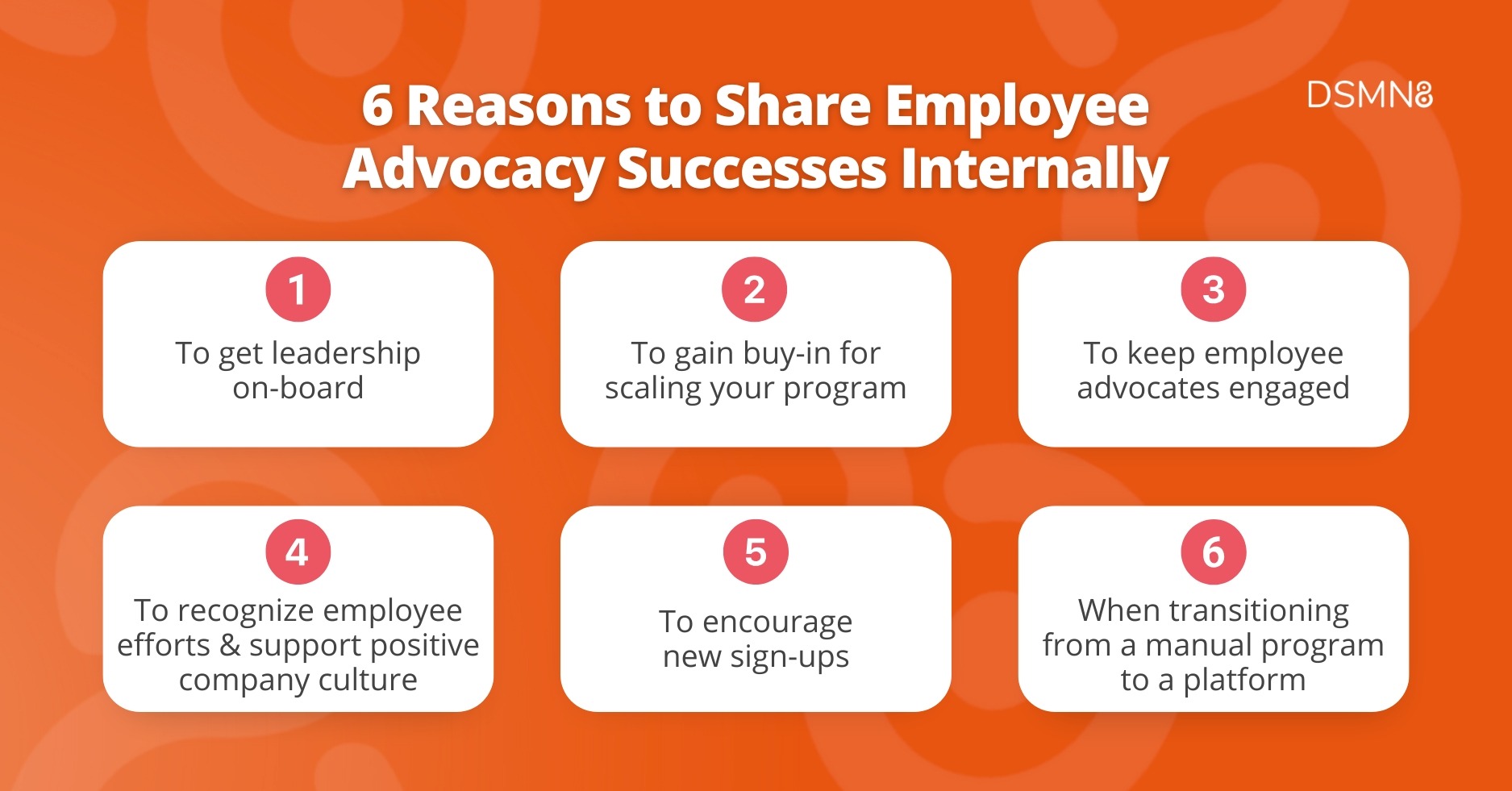
1. Get Leadership On-Board
You’re already running an employee advocacy program, so you will have some level of executive buy-in.
However, this could very well be within the marketing and sales departments. Maybe the CEO signed off on it, but they’re not actively participating.
Here’s the thing: to really make your program soar, getting the C-suite involved is key 👀
Over the past few years (and especially in 2024), executives have become increasingly active on LinkedIn, so your CEO may not need much convincing at this point.
But, for those who do need a push, sharing your program results is the best way to demonstrate the business impact and the value their participation would bring.
2. Gain Buy-In for Scaling Your Program
If you’re planning to scale your program to include different regions or departments of your organization, you’ll need buy-in.
Perhaps you need budget approval to add new users to your employee advocacy platform. But even if you manage the program without additional technology, you’ll still need support from the senior leadership of the regions or departments you’re targeting.
Share the data and anecdotal successes from your existing program as part of your business case for expansion.
There’s no more compelling argument than “This is working; let’s take it further!” 🙌
3. Keep Employees Engaged
I’ve touched on this already, but it’s worth really bringing home.
A key reason to share employee advocacy wins internally is to engage your advocates.
Celebrating the results a team have generated is a great way to incite friendly competition across departments 🏆
The same applies when highlighting individuals – especially if recognition comes from senior leadership!
When sharing overall program results for a specific time period, be sure to compare them with the previous period to celebrate any improvements. If your numbers have dropped, this can motivate more sharing.
This is also a great opportunity to share any insights or tips, as one of our clients has done in the example below 💡
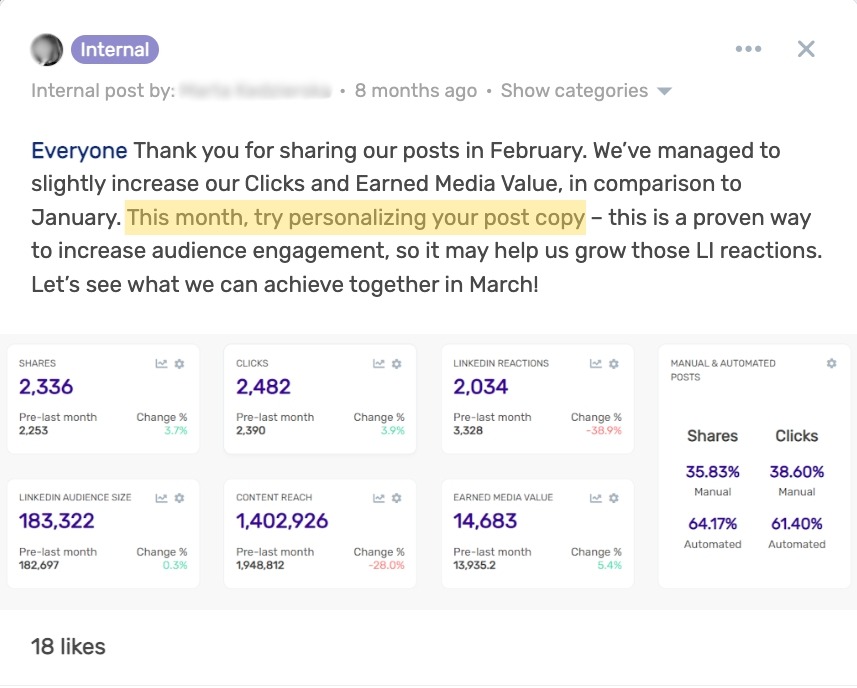
4. To Recognize Employee Advocate Efforts
We all want to be recognized for our work achievements and efforts, and employee advocates are no exception.
If you’ve noticed an advocate has gone above and beyond, give them a shoutout! 📢
Maybe they’re creating original employee-generated content or customizing the posts you’re providing. Perhaps they’re generating a lot of website traffic.
Use your employee advocacy platform’s analytics and leaderboards to discover these top performers. If you’re not using a tool, you’ll need to keep an eye on your LinkedIn feed to spot these exceptional advocates.
This is particularly effective if senior leadership is involved; employees are eager to impress the C-suite!
5. To Encourage New Sign-Ups
When aiming to expand your program, some employees will need to be a bit more convinced to join than others.
This is where analytics becomes useful.
Keep it simple: There’s no need to overwhelm or potentially confuse your potential advocates with things they may not yet understand, such as ‘earned media value.’
Instead, tell a story with the data 💬
- How much marketing budget have you saved?
- Have you had an increase in leads/sales since the program launched?
- Or an increase in applications for open positions?
Tie these metrics into your employee advocate pitch, along with the benefits for employees themselves.
6. When Transitioning from a Manual Program to a Platform
If you’ve been successfully running an employee advocacy program without using a platform, your advocates are a motivated bunch! 🙌
It certainly takes more effort to stay active on LinkedIn without time-saving features like automation, boost posts, or even just having a dedicated space for employees to quickly find content curated for them.
What I’m getting at is that these people won’t need convincing and will be keen to benefit from technology that saves them time.
However, one of the main reasons that employee advocacy program managers feel the need to start leveraging software is when planning to scale the program.
So, a great time to highlight the impact employee advocacy has had within your organization is when you’re transitioning to a platform.
You’ll be able to say to your existing advocates and other employees you’re aiming to onboard:
These are the results we have generated from your social media activity. With the support of this new tool, we’ll be able to scale the program efficiently and create an even larger impact!
8 Ways To Showcase Employee Advocacy Achievements in Your Company
Now that we’ve established the many reasons to share employee advocacy successes internally let’s move on to the how.
Here are eight opportunities for sharing program results within your organization👇
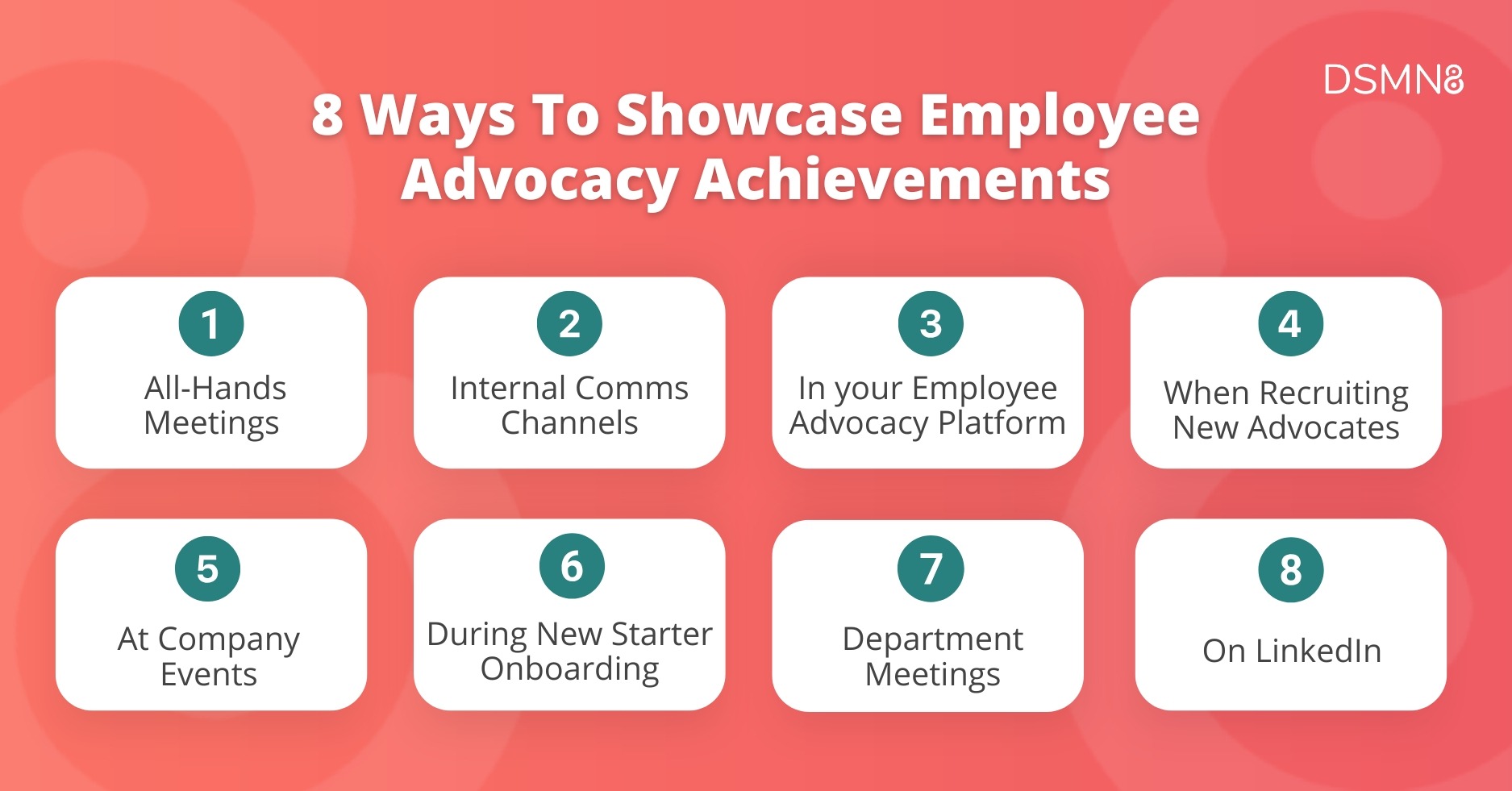
1. All-Hands Meetings
All-hands meetings provide a great opportunity to spread the word about your employee advocacy program throughout your wider organization.
Many attendees may not yet be aware of your program, so sharing successes can spark interest in getting involved.
This can form part of a general marketing update–keep it brief to maintain everyone’s attention!

2. Internal Comms Channels
Internal communications channels like Teams or Slack make it easy to draw attention to your program’s results and celebrate advocate achievements.
Sending a company-wide email is probably not the way to go, but sharing the same message in a relevant Slack channel can feel much more appropriate.
Perhaps your organization has a channel focused on celebrating company/employee successes. If so, this is the ideal place to share.
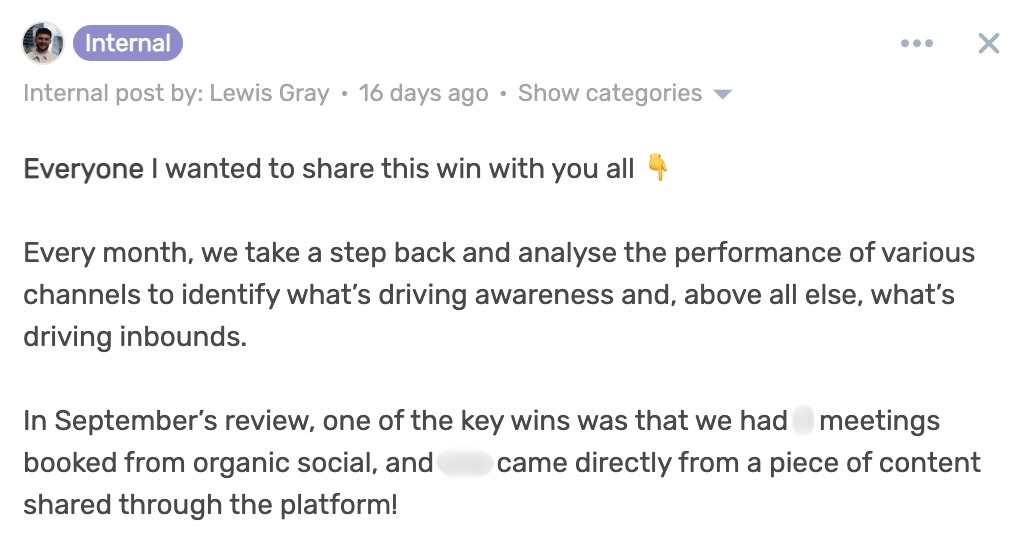
3. Internal Posts in your Employee Advocacy Platform
If you’re using an employee advocacy solution like DSMN8, there should be an internal posting function. DSMN8 also includes a ‘high five’ feature, which makes it easy to celebrate a colleague within the platform.
Although internal posts will only reach employees who are already part of the program, it’s worth providing regular updates about results. Highlighting top performers will help you create a positive culture around your program.
It’s also worth remembering that when advocates are notified about new internal posts, you’re bringing them into the platform. Then, they might check to see if there’s new content to share.
Here’s an example internal post from one of our clients. This particular admin takes the time to celebrate results and motivate their team every month. We love to see it! 👏
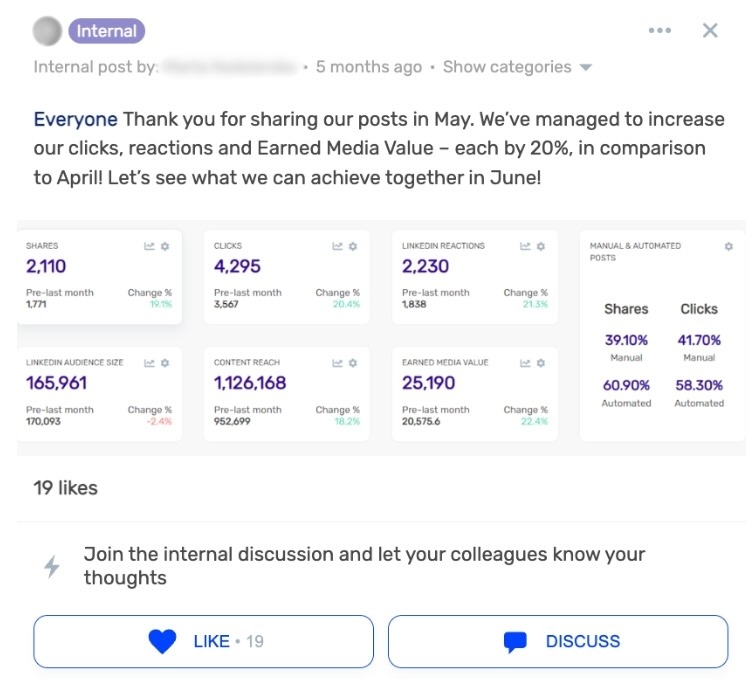
4. When Recruiting New Advocates
Looking for fresh faces in your program?
Recruiting new advocates to an existing program is much easier than starting from scratch because you’ll have results to support your value proposition.
Let’s say your sales team was the first group involved.
Get feedback from salespeople to find out first-hand how being active on LinkedIn has helped them in their roles.
Check your analytics to get the data.
Then, take screenshots of their top-performing content. This will help convey what you’re looking for.
Put this all together concisely, emphasize the benefits employees will see, and you’ve got a compelling case study for recruiting employee advocates!
5. At Company Events
Company events provide the perfect opportunity to start conversations with people outside of your immediate team.
And if you’re in a large organization, events may enable you to meet colleagues in departments you’ve never interacted with before.
Often, an in-person chat about the benefits of advocacy and the results you’ve seen is more convincing than emails or messages about it.
One of our clients leveraged an international company event to promote its employee advocacy program. They helped their colleagues sign up via their phones then and there, resulting in over a hundred new users enrolled! 🥳
The key to their success was in the preparation, supported by their DSMN8 Customer Success Manager, Emma. This team created merchandise to give out at the event, featuring their program’s brand identity. Their employee value proposition for the program was clear, and they had the data to back it up. It was a huge success.
6. During Onboarding for New Starters
Aligning with HR to ensure that new starters are aware your employee advocacy program exists is essential.
All new employees should know where to find your social media policy, too.
Without doing this, you’ll need to spend more time and effort recruiting new advocates to replace those who may leave your organization.
If every new employee knows about the program, it will be much easier to maintain a steady flow of new participants.
To make your initial pitch (or document) more convincing, highlight key program successes/results.
7. Department Meetings
Each department head should know how their team is performing in your advocacy program. This could be compared to their own metrics (e.g., clicks and shares vs. the previous month) or with other departments for a competitive element.
Encourage them to celebrate these results in their own meetings. When the department leader is invested, their team are more likely to be motivated as well.
As an admin or program manager, you should let department heads know if someone on their team has performed exceptionally well or created standout content.
8. On LinkedIn
Don’t forget that one of the best places to reach employees is actually external: on LinkedIn.
The LinkedIn algorithm is geared so that content by your colleagues is prioritized in your feed.
While you’re unlikely to want to share all the metrics from your advocacy program externally, you could certainly use LinkedIn to congratulate your employee advocates and even give shoutouts to individual program contributors.
According to Edelman, 54% of C-level executives spend an hour or more per week reading thought leadership content. Sharing on LinkedIn might just grab the attention of your CEO in a way that a message in a Slack channel may not.
This engagement contributes to program results while demonstrating a positive company culture to any potential recruits searching for your organization on social media. It’s a win-win 👏
Here’s a great example from Kadi Poll at Bolt. Her posts about Bolt’s employee advocacy program have garnered a lot of attention on LinkedIn.
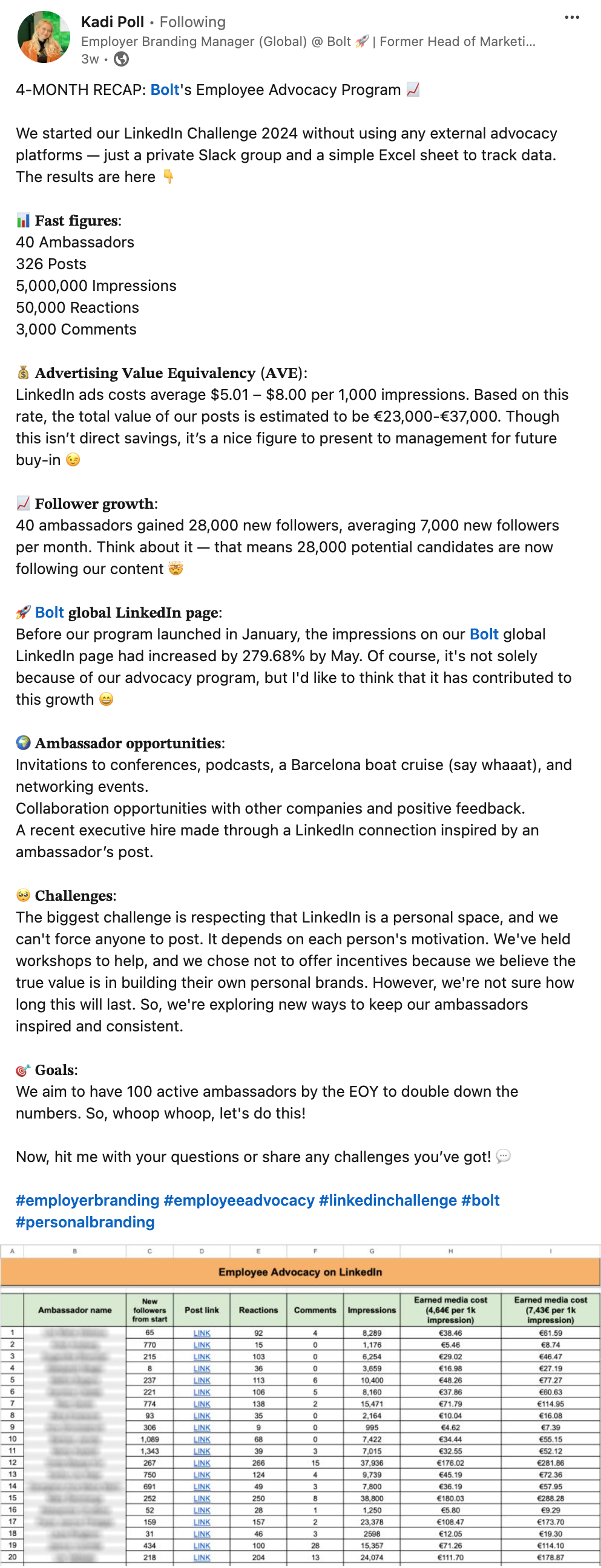
Which Employee Advocacy Results to Highlight
Finally, you’ll need to consider which metrics and success stories to share.
The right numbers to emphasize can vary depending on your program goals.
For example, if you’re focusing on talent acquisition and employer branding, an increase in applicants from social media would be a key positive indication that your program is working.
Or, if your primary aim is to support the sales team, your North Star will be attributing leads and sales to your advocacy program (with UTM tracking, for example).
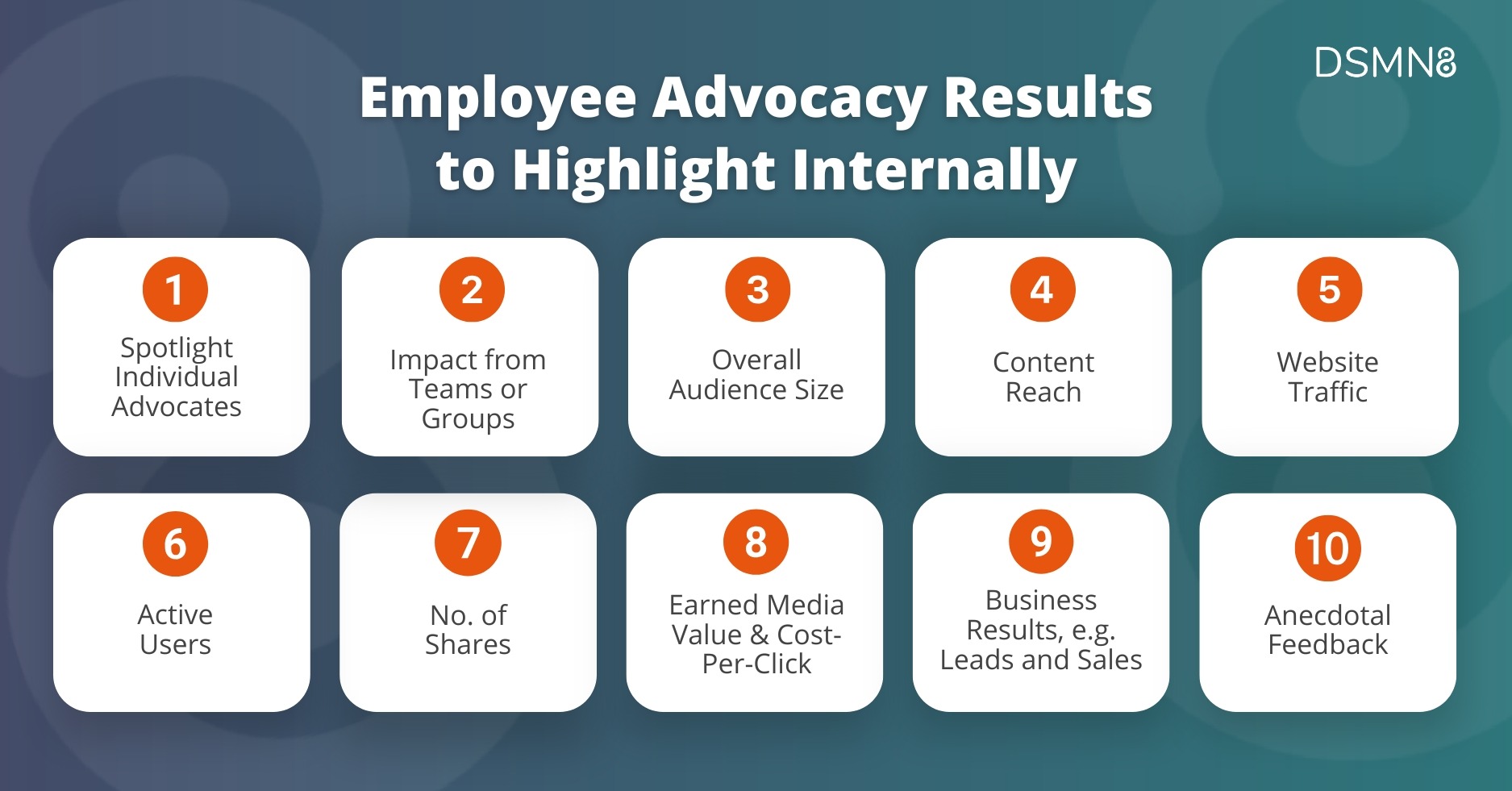
These metrics can be easily tracked with DSMN8’s analytics suite. If you’re running a program without a platform, lean on Google Analytics for organic social metrics and anecdotal feedback from your advocates and sales team.
Additional Resources
You should now feel ready to start sharing those employee advocacy wins with your wider organization and have a clear understanding of the benefits of doing so.
Check out these helpful resources for more ways to maintain employee advocacy program buy-in and encourage employee engagement:
Emily Neal
SEO and Content Specialist at DSMN8. Emily has 10 years experience blogging, and is a pro at Pinterest Marketing, reaching 1 million monthly views. She’s all about empowering employees to grow their personal brands and become influencers.



